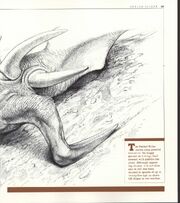
"The secret egg chamber filled with rain and protective mud."
The Keeled Slider is a large, herbivorous bipedalien with brown, leathery skin, from the larger foothills of the Equatorial Mountains of Darwin IV. It was discovered in June, 2359, during the First Darwinian Expedition, near the Fugum Shingen. It is one of the few creatures on the planet to not be hermaphroditic.
Far up in the highlands of the Equatorial Mountains, there will be signs of these creatures from great furrows dug into the yielding turf, as if some giant had pulled its fingers through the blue hillvine foliage to reveal the brown soil beneath. The grooves crisscross the hills in seemingly random patterns. Accompanying them at intervals are deep scuff marks and the occasional clump of droppings. The scuffs and the grooves indicate that these large creatures pull themselves along, dragging a portion of their bodies.
High on a hilltop surmounted by a large igneous plug, a pair of keeled sliders will be huddled under an overhanging rock, motionless save for small movements of their crescent-shaped heads. There is very little in the way of sonar; they ping infrequently and for short duration.
When low clouds grow darker and it begins to drizzle or rain hard, there is suddenly a loud burst of high frequency pings. One of the keeled sliders will move back a meter or so, while the other appears to grow restless, shifting from one muscular, paddle-like paw to the other. Its companion continues to move slowly backward until it finally settles directly under a large shelf of overhanging rock out of the pouring rain. Its sides begin to swell with some inexplicable effort. With each spasm the creature gives voice to a piercing sonar squeal that seems to increase the agitation of its mate, which by now is bobbing its huge head heavily. After 20 such squeals, it is determined that the slider under the overhang is a female. She excavates a long narrow channel underground with her tubular ovipositor and lays 20 long eggs in a small chamber about 5 meters below. She eases herself off of the nest site and slowly slides forward into the rain, her limp, distended ovipositor trailing in the mud. The male slider is by now in a positive frenzy of excitement and hurried without ceremony to the vacated tunnel. He quickly inserts his phallus into the opening made by his mate, and within two minutes completes the task of fertilizing the subterranean ova. Now also spent, he then slides off the nest to stand mutely next to his trembling partner, the rain bouncing off the their broad backs. They will shakily nuzzle each other, pinging gently. They settle down into the cradling mud, and by the gradual relaxing of their dorsal and lateral spines it is believed that they are dozing. Behind the pair, the narrow passageway and its secret egg chamber will fill with rain and protective mud.

The keeled slider's two facial feeding palps also are used in digging its egg chamber. The female then lays eggs far underground, where they are fertilized by the male - and at first it was thought that the eggs were apparently abandoned to their fate by both parents, but the parents actually return to the nest after feeding and the young are nurtured upon hatching.
The rainstorms will soften the rich soil to exactly the right consistency to allow the keeled sliders to burrow out their nests; there can be other pairs atop similar volcanic ridges. Hours later, as the sunslight pours through the dissipating clouds and forms magnificent double rainbows, something is different at many of the nest sites. All are unoccupied by adult sliders, the only sign of their presence being the parallel furrows cut into the ground. As for the egg chambers, virtually no sign of them can be found. Generally, egg-born young on Darwin IV are precocial and live-born young on the planet are altricial. Exceptions to this rule exist, such as the nurturing keeled sliders whose egg-born, altricial young are in the parent's tow for about two years and need much attention.

The keeled slider leaves deep parallel furrows in the boggy ground as it drags itself forward with paddle-like paws. Although appearing clumsy, it is not slow and in fact has been clocked at speeds of up to 25 kilometers per hour on downhill slopes in wet weather.
